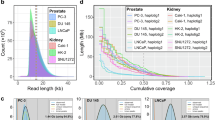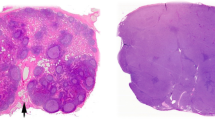Abstract
Comparative genomic hybridization (CGH) analyses have detected gains of copy number on 13q, especially at 13q31-q32, in cell lines and primary cases of various types of lymphoma. Since amplification of chromosomal DNA is one of the mechanisms that can activate tumor-associated genes, and because 13q amplification had been reported in various other types of tumors as well, we attempted to define by fluorescence in situ hybridization (FISH) a common region at 13q31-q32 in which to explore genes that might be targets for the amplification events. Although the commonly amplified region we defined was relatively large (approximately 4 Mb), only one true gene, GPC5, was found there. GPC5 was over-expressed in lymphoma cell lines that had shown amplification, in comparison with those that had not. Our findings suggest that GPC5 is a likely target for amplification, and that over-expression of this gene may contribute to development and/or progression of lymphomas and other tumors.
Similar content being viewed by others
Log in or create a free account to read this content
Gain free access to this article, as well as selected content from this journal and more on nature.com
or
References
Albertson DG, Ylstra B, Segraves R, Collins C, Dairkee SH, Kowbel D, Kuo WL, Gray JW, Pinkel D (2000) Quantitative mapping of amplicon structure by array CGH identifies CYP24 as a candidate oncogene. Nat Genet 25:144–146
Allen JE, Hough RE, Goepel JR, Bottomley S, Wilson GA, Alcock HE, Baird M, Lorigan PC, Vandenberghe EA, Hancock BW, Hammond, DW (2002) Identification of novel regions of amplification and deletion within mantle cell lymphoma DNA by comparative genomic hybridization. Br J Haematol 116:291–298
Ariyama Y, Mori T, Shinomiya T, Sakabe T, Fukuda Y, Kanamaru A, Yamada Y, Isobe M, Seto M, Nakamura Y, Inazawa J (1999) Chromosomal imbalances in adult T-cell leukemia revealed by comparative genomic hybridization: gains at 14q32 and 2p16-22 in cell lines. J Hum Genet 44:357–363
David G, Lories V, Decock B, Marynen P, Cassiman JJ, Van den Berghe H (1990) Molecular cloning of a phosphatidylinositol-anchored membrane heparan sulfate proteoglycan from human lung fibroblasts. J Cell Biol 111:3165–3176
Filmus J, Church J, Buick RN (1988) Isolation of a cDNA corresponding to a developmentally regulated transcript in rat intestine. Mol Cell Biol 8:4243–4249
Filmus J, Selleck SB (2001) Glypicans: proteoglycans with a surprise. J Clin Invest 108:497–501
Filmus J, Song HH (2000) Glypicans. In: Iozzo RV (ed) Proteoglycans. Marcel Dekker, New York, USA, pp 161–176
Fukuda Y, Kurihara N, Imoto I, Yasui K, Yoshida M, Yanagihara K, Park JG, Nakamura Y, Inazawa J (2000) CD44 is a potential target of amplification within the 11p13 amplicon detected in gastric cancer cell lines. Genes Chromosomes Cancer 29:315–324
Houldsworth J, Mathew S, Rao PH, Dyomina K, Louie DC, Parsa N, Offit K, Chaganti RS (1996) REL proto-oncogene is frequently amplified in extranodal diffuse large cell lymphoma. Blood 87:25–29
Hsu HC, Cheng W, Lai PL (1997) Cloning and expression of a developmentally regulated transcript MXR7 in hepatocellular carcinoma: biological significance and temporospatial distribution. Cancer Res 57:5179–5184
Imoto I, Yang ZQ, Pimkhaokham A, Tsuda H, Shimada Y, Imamura M, Ohki M, Inazawa J (2001) Identification of cIAPI as a candidate target gene within an amplicon at 11q22 in esophageal squamous cell carcinomas. Cancer Res 61:6629–6634
Inazawa J, Saito H, Ariyama T, Abe T, Nakamura Y (1993) High-resolution cytogenetic mapping of 342 new cosmid markers including 43 RFLP markers on human chromosome 17 by fluorescence in situ hybridization. Genomics 17:153–162
Kleeff J, Ishiwata T, Kumbasar A, Friess H, Büchler MW, Lander AD, Korc M (1998) The cell surface heparan sulfate proteoglycan glypican-1 regulates growth factor in pancreatic carcinoma cells and is over-expressed in human pancreatic cancer. J Clin Invest 102:1662–1673
Knuutila S, Bjorkqvist AM, Autio K, Tarkkanen M, Wolf M, Monni O, Szymanska J, Larramendy ML, Tapper J, Pere H, El-Rifai W, Hemmer S, Wasenius VM, Vidgren V, Zhu Y (1998) DNA copy number amplifications in human neoplasms: review of comparative genomic hybridization studies. Am J Pathol 152:1107–1123
Lin H, Huber R, Schlessinger D, Morin PJ (1999) Frequent silencing of the GPC3 gene in ovarian cancer cell lines. Cancer Res 59:807–810
Litwack ED, Stipp CS, Kumbasar A, Lander AD (1994) Neuronal expression of glypican, a cell surface glycosylphosphatidylinositol-anchored heparan sulfate proteoglycan, in the adult rat nervous system. J Neurosci 14:3713–3724
Mao X, Lillington D, Child F, Russell-Jones R, Whittaker S (2002) Comparative genomic hybridization analysis of primary cutaneous B-cell lymphomas: identification of common genomic alterations in disease pathogenesis. Genes Chromosomes Cancer 35:144–155
Mehra S, Messner H, Minden M, Chaganti RSK (2002) Molecular cytogenetic characterization of non-Hodgkin lymphoma cell lines. Genes Chromosomes Cancer 33:225–234
Murthy SS, Shen T, Rienzo AD, Lee WC, Ferriola PC, Jhanwar SC, Mossman BT, Filmus J, Testa JR (2000) Expression of GPC3, an X-linked recessive overgrowth gene, is silenced in malignant mesothelioma. Oncogene 19:410–416
Neat MJ, Foot N, Jenner M, Goff L, Ashcroft K, Burford DH, Dunham A, Norton AT, Lister A, Fitzgibbon J (2001) Localisation of a novel region of recurrent amplification in follicular lymphoma to an ~6.8 Mb region of 13q32–33. Genes Chromosomes Cancer 32:236–243
Paine-Saunders S, Viviano BL, Saunders S (1999) GPC6, a novel member of the glypican gene family, encodes a product structurally related to GPC4 and is colocalized with GPC5 on human chromosome 13. Genomics 57:455–458
Pellegrini M, Pilia G, Pantano S, Lucchini F, Uda M, Fumi M, Cao A, Schlessinger D, Forabosco A (1998) GPC3 expression correlates with the phenotype of the Simpson-Golabi-Behmel syndrome. Dev Dyn 213:431–439
Rao PH, Houldsworth J, Dyomina K, Parsa NZ, Cigudosa JC, Louie DC, Popplewell L, Offit K, Jhanwar SC, and Chaganti RSK (1998) Chromosomal and gene amplification in diffuse large B-cell lymphoma. Blood 92:234–240
Saunders S, Paine-Saunders S, Lander AD (1997) Expression of the cell surface proteoglycan glypican-5 is developmentally regulated in kidney, limb, and brain. Dev Biol 190:78–93
Stark GR, Debatisse M, Giulott E, Wahl GM (1989) Recent progress in understanding mechanisms of mammalian DNA amplification. Cell 57:901–908
Stipp CS, Litwac ED, Lander AD (1994) Cerebroglycan: an integral membrane sulfate proteoglycan that is unique to the developing nervous system and expressed specifically during neuronal differentiation. J Cell Biol 124:149–160
Veugelers M, Vermeesch J, Reekmans G, Steinfeld R, Marynen P, David G (1997) Characterization of glypican-5 and chromosomal localization of human GPC5, a new member of the glypican gene family. Genomics 40:24–30
Veugelers M, De Cat B, Ceulemans H, Bruystens AM, Coomans C, Durr J, Vermeesch J, Marynen P, David G (1999) Glypican-6, a new member of the glypican family of cell surface proteoglycans. J Biol Chem 274:26968–26977
Watanabe K, Yamada H, Yamaguchi Y (1995) K-glypican: a novel GPI-linked heparan sulfate proteoglycan that is highly expressed in developing brain and kidney. J Cell Biol 130:1207–1218
Wittwer CT, Ririe KM, Andrew RV, David DA, Gundry RA, Balis UJ (1997) The Lightcycler: a microvolume multisample fluorimeter with rapid temperature control. Biotechniques 22:176–181
Acknowledgements
We thank Dr. Masao Seto (Aichi Cancer Center) for giving us information of CGH data in lymphoma cell lines used in the present study, and also thank Professor Yusuke Nakamura (Institute of Medical Science, The University of Tokyo) for his continuous encouragement. This work was supported by Grants-in-Aid for Scientific Research on Priority Areas (C) from the Japanese Ministry of Education, Culture, Sports, Science, and Technology, and by Core Research for Evolutional Science and Technology (CREST) of the Japan Science and Technology Corporation.
Author information
Authors and Affiliations
Corresponding author
Rights and permissions
About this article
Cite this article
Yu, W., Inoue, J., Imoto, I. et al. GPC5 is a possible target for the 13q31-q32 amplification detected in lymphoma cell lines. J Hum Genet 48, 331–335 (2003). https://doi.org/10.1007/s10038-003-0026-2
Received:
Accepted:
Published:
Issue date:
DOI: https://doi.org/10.1007/s10038-003-0026-2
Keywords
This article is cited by
-
Blood vessel remodeling in the cerebral cortex induced by binge alcohol intake in mice
Toxicological Research (2023)
-
Prognostic value of Glypican family genes in early-stage pancreatic ductal adenocarcinoma after pancreaticoduodenectomy and possible mechanisms
BMC Gastroenterology (2020)
-
The Role of Cell Growth-Related Gene Copy Number Variation in Autoimmune Thyroid Disease
Biological Trace Element Research (2020)
-
Antithetic roles of proteoglycans in cancer
Cellular and Molecular Life Sciences (2012)
-
Genomic alterations in rectal tumors and response to neoadjuvant chemoradiotherapy: an exploratory study
Radiation Oncology (2011)



